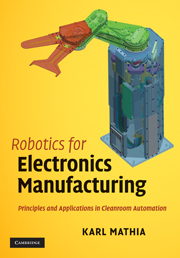Book contents
- Frontmatter
- Contents
- Preface
- 1 Industrial robotics
- 2 Cleanroom robotics
- 3 Design of atmospheric robots
- 4 Design of vacuum robots
- 5 Kinematics
- 6 Dynamics and control
- 7 Test and characterization
- Appendix A SI units and conversion tables
- Appendix B Standards organizations
- Appendix C Standard temperature and pressure (STP)
- References
- Index
2 - Cleanroom robotics
Published online by Cambridge University Press: 06 July 2010
- Frontmatter
- Contents
- Preface
- 1 Industrial robotics
- 2 Cleanroom robotics
- 3 Design of atmospheric robots
- 4 Design of vacuum robots
- 5 Kinematics
- 6 Dynamics and control
- 7 Test and characterization
- Appendix A SI units and conversion tables
- Appendix B Standards organizations
- Appendix C Standard temperature and pressure (STP)
- References
- Index
Summary
Manufacturing in cleanroom environments
Clean environments are required for manufacturing modern electronics devices, in particular semiconductor devices, but also hard disks, flat panel displays (FPDs), and solar panels. Wafer processing in the semiconductor industry includes some of the most demanding processes in terms of complexity and cleanliness, due to the submicron dimensions of modern semiconductor devices. This book focuses on industrial cleanroom robotics in semiconductor and FPD manufacturing. Both industries experienced phenomenal technical advancement and growth in the 1980s and 1990s and have established manufacturing facilities in several geographic regions: North America, Europe, and Asia/Pacific Rim. India may emerge as another manufacturing region. The market for semiconductor manufacturing equipment was valued at approximately US$45.5 billion in 2007. The market for FPD manufacturing equipment surpassed the US$1 billion mark in 1997 for the first time. In 2008 it was estimated at US$10 billion.
Cleanroom requirements
Cleanrooms are isolated environments in which humidity, temperature, and particulate contamination are monitored and controlled within specified parameters (SEMI standard E70). Particulates are fine particles, solid or liquid, that are suspended in a gas. Particulate sizes range from less than 10 nm to more than 100 µm. Particulates of less than 100 nm are called ultra-fine particles. Here the term ‘particle’ is used throughout, representing particles of all applicable sizes, either suspended in a gas or attached to a surface. Cleanroom environments are required if particle contamination is a concern, as is the case, for example, in semiconductor manufacturing.
Information
- Type
- Chapter
- Information
- Robotics for Electronics ManufacturingPrinciples and Applications in Cleanroom Automation, pp. 12 - 29Publisher: Cambridge University PressPrint publication year: 2010
